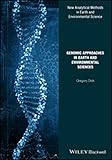Genomic approaches in earth and environmental sciences / Gregory Dick.
Material type: TextSeries: New analytical methods in earth and environmental sciencePublisher: Hoboken, NJ : Wiley-Blackwell, [2019]Copyright date: ©2019Description: 1 online resource : color illustrationsContent type:
TextSeries: New analytical methods in earth and environmental sciencePublisher: Hoboken, NJ : Wiley-Blackwell, [2019]Copyright date: ©2019Description: 1 online resource : color illustrationsContent type: - text
- computer
- online resource
- 9781118708200
- 1118708202
- 9781118708231
- 1118708237
- 363.7 23
- GE105
Online resource; title from PDF title page (EBSCO, viewed March 26, 2018).
Includes bibliographical references and index.
Cover; Title Page; Copyright; Contents; Preface; Acknowledgments; Abbreviations; Chapter 1 Introduction; 1.1 Exploring the Microbial World; 1.2 The DNA Sequencing Revolution: Historical Perspectives; References; Chapter 2 The Architecture of Microbial Genomes; Introduction; 2.1 Genome Size, Organization, and Replication; 2.2 Nucleotide Composition; 2.3 Ecological and Evolutionary Aspects of Microbial Genomes; 2.3.1 The Role of Viruses in Promoting Genomic Diversity; 2.4 Genomic Diversity in Microbial Communities; 2.5 Does Genomic Diversity Matter?; References.
Chapter 3 Application of Omics Approaches to Earth and Environmental Sciences: Opportunities and ChallengesIntroduction; 3.1 New Perspectives on Microbial Biogeochemistry; 3.1.1 Redefining the Carbon and Nitrogen Cycles; 3.1.2 Omics as Sensitive and Efficient Tracers of Biogeochemical Processes; 3.1.3 Omics Data is Valuable for Biogeochemical Models; 3.1.4 Understanding Biotic Responses and Feedbacks to Global Change; 3.2 A Genomic Record of Biological and Geochemical Evolution; 3.3 Challenges and Limitations of Omics Approaches; 3.4 Omics as a Complement to Other Approaches; References.
Chapter 4 Overview of Approaches: From Whole-Community Shotgun Sequencing to Single-Cell GenomicsIntroduction; 4.1 Choosing the Right Approach; 4.1.1 Whole-Community Approaches; 4.1.2 Targeted Approaches: Physical, Microbiological, and Isotopic Enrichment; 4.1.3 Single-Cell Genomics; 4.2 Experimental Design and Sampling Considerations; 4.2.1 Replication; 4.2.2 Estimating Sequencing Effort: How Much Sequencing Do I Need to Do?; 4.2.3 From Sample to Data: Biases Due to Preservation, Storage, Extraction, and Sequencing; 4.2.4 Estimating Absolute Abundance with Internal Standards.
4.3 Overview of Current DNA Sequencing Technologies4.4 Quality Control and Sequence Processing; 4.4.1 Dereplication; 4.4.2 Trimming; References; Chapter 5 Genomics of Single Species and Single Cells; Introduction; 5.1 Algorithms for Genome Assembly; 5.2 Challenges of Genome Assembly; 5.3 Scaffolding; 5.4 Programs and Pipelines for Genome Assembly; 5.5 Evaluation of Genome Assemblies; 5.6 Single-Cell Genomics; References; Chapter 6 Metagenomics: Assembly and Database-Dependent Approaches; Introduction; 6.1 To Assemble or Not To Assemble?; 6.2 Database-Dependent Approaches.
6.3 Database-Independent Approaches: De Novo Assembly6.4 Evaluation of Metagenomic Assemblies; 6.5 A Philosophy of Metagenome Assemblies; References; Chapter 7 Metagenomic Binning; Introduction; 7.1 Genomic Signatures of Nucleotide Composition; 7.2 Binning Programs; 7.3 Additional Signal and Steps for Binning: Coverage, Taxonomic Data, and Mini-Assemblies; 7.4 Identifying, Evaluating, and Assessing the Completeness of Genomic Bins; References; Chapter 8 Annotation: Gene Calling, Taxonomy, and Function; Introduction; 8.1 Gene Calling; 8.2 Determining Taxonomic Composition.
The first comprehensive synthesis of genomic techniques in earth sciencesThe past 15 years have witnessed an explosion of DNA sequencing technologies that provide unprecedented insights into biology. Although this technological revolution has been driven by the biomedical sciences, it also offers extraordinary opportunities in the earth and environmental sciences. In particular, the application of "omics" methods (genomics, transcriptomics, proteomics) directly to environmental samples offers exciting new vistas of complex microbial communities and their roles in environmental and geochemical processes. This unique book fills the gap where there exists a lack of resources and infrastructure to educate and train geoscientists about the opportunities, approaches, and analytical methods available in the application of omic technologies to problems in the geosciences.Genomic Approaches in Earth and Environmental Sciences begins by covering the role of microorganisms in earth and environmental processes. It then goes on to discuss how omics approaches provide new windows into geobiological processes. It delves into the DNA sequencing revolution and the impact that genomics has made on the geosciences. The book then discusses the methods used in the field, beginning with an overview of current technologies. After that it offers in-depth coverage of single cell genomics, metagenomics, metatranscriptomics, metaproteomics, and functional approaches, before finishing up with an outlook on the future of the field.The very first synthesis of an important new family of techniquesShows strengths and limitations (both practical and theoretical) of the techniquesDeals with both theoretical and laboratory basicsShows use of techniques in a variety of applications, including various aspects of environmental science, geobiology, and evolutionGenomic Approaches in Earth and Environmental Sciences is a welcome addition to the library of all earth and environmental scientists and students working within a wide range of subdisciplines.
There are no comments on this title.
